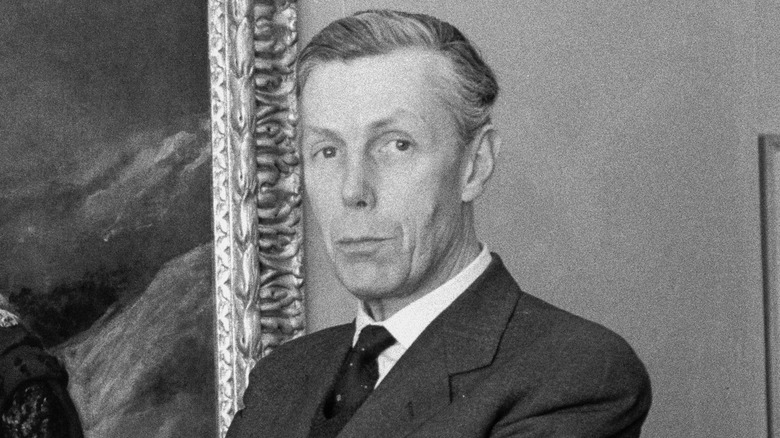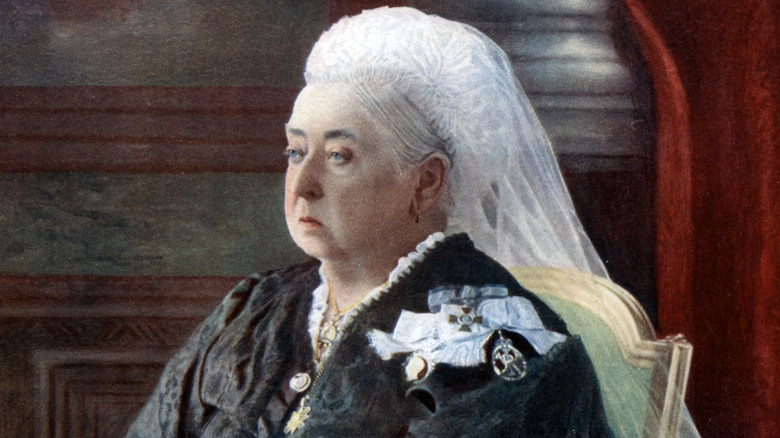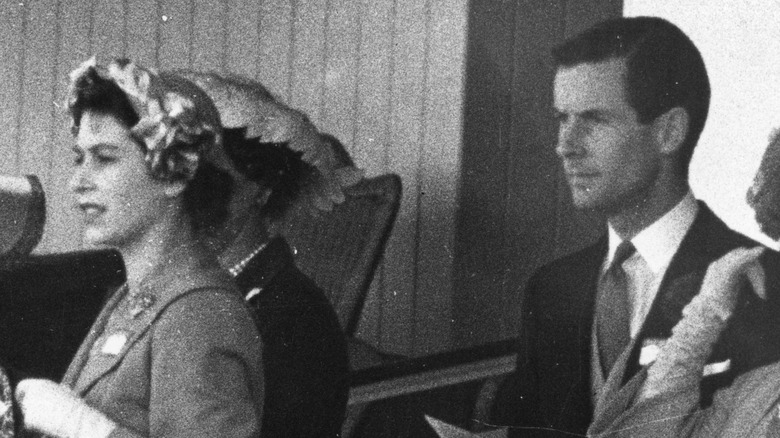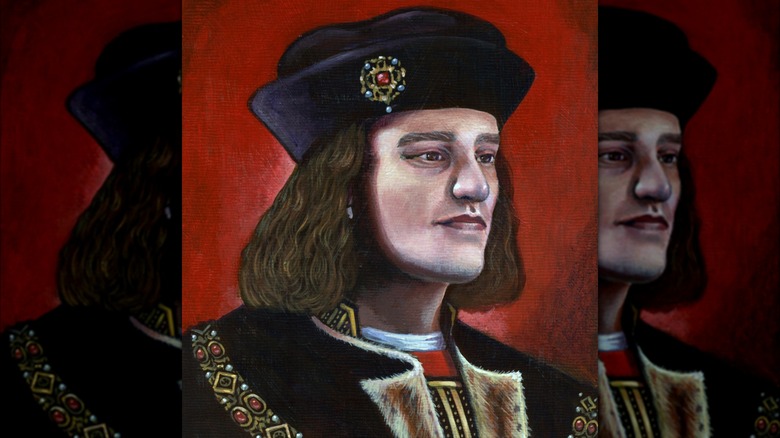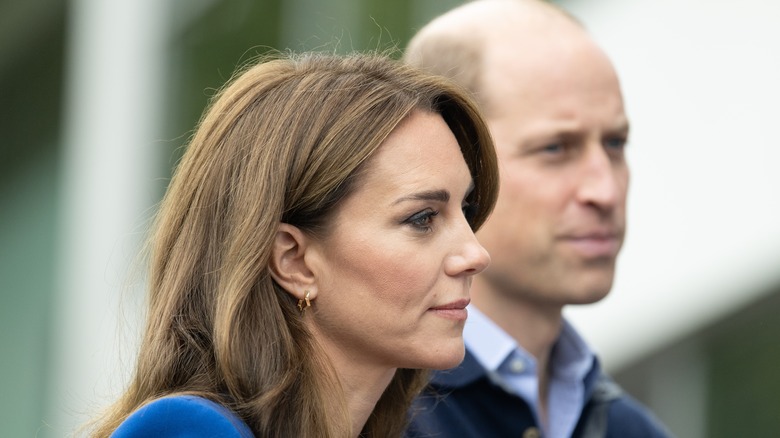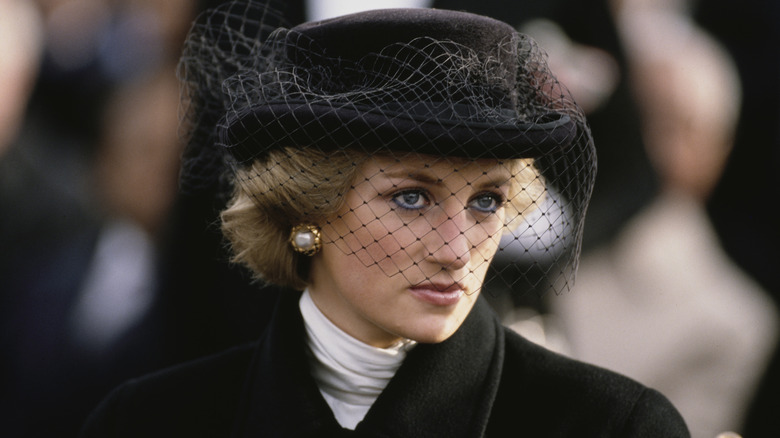The Royal Family's Worst Secrets Exposed
The following article includes mention of suicide.
The British royal family has long been a source of interest, as its members act in a certain, refined manner while in public. But in private, they're just like everyone else; many members have caused controversy, had extramarital affairs, or any of a million things that prove being a royal is a stressful existence without much privacy.
Because so many people outside of the royal family enjoy peeking inside, there have been quite a few scandals that have come out over the years. These stories tend to make headlines, so most folks are aware of the time Prince Harry dressed up as a Nazi for a costume party or the issues concerning Princess Diana and the rest of the family.
Of course, those are the stories the public is aware of, but there's far more going on than most people realize. The royal family has been around for centuries, and there have been plenty of secret scandals that have come about during their rule. The secrets below are some of the worst dark truths the Royal Family would have preferred didn't come to light.
The royal family kept Prince John from the public
The royal family has long been a beacon of strength — at least, that's the image they want to present to the world. Because of this, a child born with illnesses or disabilities is often pushed from the public eye. This was seemingly the case for Prince John, the fifth child of King George V and Queen Mary.
Johnnie, as he was called by the family, was 4 when doctors diagnosed him with epilepsy. He remained with the family until 1916, when his condition became more difficult to treat. When this happened, Prince John was sent to Sandringham House, one of the family properties in Norfolk, England. He remained there under the care of a governess for a few years.
John died following a severe seizure on January 18, 1919 at just 13 years old. His illness was only disclosed to the public after his death, so for quite some time, the public likely had no idea anything was wrong with him. The family later came under scrutiny for hiding John away, but in reality, he was well cared for and only left the public eye when his condition became too severe.
Former King Edward VIII's Nazi ties
The world today would look much different had King Edward VIII not abdicated his throne to marry Wallis Simpson. The reason for this is simple: Edward drank the Nazi Kool-Aid, and had he remained king, the United Kingdom's involvement in World War II could have been very different from the history we know.
It's believed that Edward didn't merely support the Nazis — some historians have posited that he actively worked with them throughout WWII. If this were true, that would make the former king of England a traitor to the crown and its people. Edward's Nazi sympathies didn't come more into public light until he married Simpson because, after their wedding, the newlyweds toured Nazi Germany. After their visit, Edward wrote a letter to Adolf Hitler, thanking him for everything he did for them.
In 1939, Edward released a broadcast asking Britain to "come to terms" with Nazi Germany, as revealed in the documentary, "Edward VIII: Britain's Traitor King" (via CBC). That, and much more documentary evidence, has since revealed Edward's shameful ties to the Nazis.
There's a vampire among the royal family
The royal family's lineage is complex because of several factors, including marrying into royal families of other nations. Throw some wars in for good measure, and history gets a touch murky about who's related to whom. One familial relation that isn't so much a secret as it is fascinating is that King Charles III is related to Vlad Tepes — a.k.a. Vlad Dracula and Vlad the Impaler — the man whose cruelty and name inspired Bram Stoker to write "Dracula."
While he was still prince, Charles contributed to a 2011 documentary about the Carpathian Mountains, "Wild Carpathia." In the project, Charles boasts about his ancestor, saying, "The genealogy shows I am descended from Vlad the Impaler, so I do have a bit of a stake in the country."
Snopes followed the trail and confirmed the genealogy — King Charles is a vampire. Or, actually, his royal lineage goes back far enough to include the former ruler of Wallachia. On top of that, Charles owns property in Transylvania. The familial connection stems from Queen Mary, the queen consort of George V, making Charles Vlad's great-grandson 16 times removed.
Queen Elizabeth had no qualms about letting a spy in her inner circle
Anthony Blunt was an art historian who worked for MI5 during World War II, and in 1945, he became the Surveyor of the King's Pictures for King George VI. After the king's death, Blunt continued working in his position for the newly-crowned Queen Elizabeth II, and he was considered a valuable member of her inner circle.
Unfortunately, he passed secrets to the Soviets for years. Blunt had become enamored with communism, becoming a spy in the 1930s, and, while he was employed MI5, began giving sensitive material to the Soviet Union. Throughout his time working in this capacity as a double agent, Blunt handed over thousands of documents to his KGB handlers. After the end of the war, his espionage eventually subsided.
Despite this, Blunt's actions were ultimately uncovered by MI5 in 1964. He was offered immunity for a confession, which he ultimately gave. Blunt revealed the names of several co-conspirators, and while the queen was aware of all of this, she retained Blunt in her service. He was allowed to retire in 1972 — eight years after being outed. After retirement, Blunt continued advising the queen in an honorary position.
King George V could have saved the Romanov family
The Romanov family's demise is well known thanks to a cultural focus on the youngest daughter, Anastasia. The Romanovs ruled Russia since the early 17th century, but the February Revolution of 1917 saw that rule come to an end, while the October Revolution saw them all imprisoned in Yekaterinburg, Russia. The entire family was lined up and murdered in July 1918.
It turns out that the Romanovs' deaths might have been prevented if King George V followed through with his initial goal of saving them. George was Tsar Nicholas II and his wife, Alexandra's, cousin, and it was believed that he would help save the Romanov family. In his letters, George wrote about his worry for his family in Russia, but there were problems. Britain initially agreed to grant the family asylum, but George pulled it back.
The biggest concern at the time was upsetting the new government in Russia. World War I was underway, and neither Britain nor its allies in Europe could afford to anger Russia. Because of this, among other reasons, George changed his mind and rescinded the offer of rescue and asylum. Once the Bolsheviks took over, it was too late, and the family's fate was sealed.
Queen Victoria was no fan of her children
Queen Victoria ruled Great Britain and Ireland for almost 64 years, making up the period known as the Victorian Era. Victoria married Prince Albert of Saxe-Coburg and Gotha, and they did what royals do: they had a lot of children. Victoria had a total of nine kids: Victoria, Edward VII, Alice, Alfred, Helena, Louise, Arthur, Leopold, and Beatrice. With so many, you'd think Victoria liked children, but it turns out she didn't.
While she had a large family, she didn't want one, and reportedly told (via the New York Post) her uncle, Belgium's King Leopold, "I think you will see with me the great inconvenience a large family would be to us all." Albert apparently didn't share in his wife's disdain of their offspring, once telling her, "It is a pity you find no consolation in the company of your children."
While she was the ruler of the British Empire, being a woman in an age named after her didn't make Victoria any less susceptible to the imposition of being forced to raise children. It was considered to be a woman's noble calling, and for Victoria, it was doubly so; as a royal, she was expected to issue offspring who would take her crown one day. But that didn't change the fact she thought that "an ugly baby is a very nasty object."
Prince Charles was pressured into marrying Diana while in love with Camilla
One of the biggest scandals to plague the royal family during the 20th century was the marriage and subsequent divorce of then-Prince Charles and Princess Diana. The couple first met in 1977, when Charles was 29 and Diana was 16. Three years later, Charles began courting Diana, and the following year, they became engaged. They tied the knot on July 29, 1981 in a lavish fairytale wedding.
What wasn't known at the time was that Charles was already having an extramarital relationship with Camilla Parker Bowles, who had been married since 1973 and the woman he would eventually wed in 2005. Around the time of his courtship with Diana, the royal family was pressuring Charles to get married. He was 30 and unwed, and the family wanted him to settle down with a young aristocratic woman without any skeletons in her closet.
Charles couldn't have married Camilla, as she didn't fit the ideal spouse the family saw fit to marry him. As a result, the family pressured Charles into proposing to a woman 13 years his junior despite being in love with someone else. Of course, the marriage didn't work out, and they divorced in 1996. Diana was tragically killed in a car accident the following year, and in 2005, Charles finally married Camilla and they live a lavish life together.
Prince Philip's sisters married Nazis
Prince Philip was the husband of Queen Elizabeth II, and he came from Greek and Danish royalty. Philip had four sisters: Margarita, Theodora, Cecilie, and Sophie. While Philip went off to join the British royal family, his sisters remained back home, and three of them married prominent people in the Nazi party. Indeed, the three women were deeply involved with Nazi affairs and were banned from attending Philip's wedding in 1947.
Sophie and Margarita both married German aristocrats who became popular members of the Nazi Party. Sophie was friends with none other than Hermann Goering, the leader of the Luftwaffe, Nazi Germany's air force, throughout WWII. Sophie reportedly once had Adolf Hitler and Goering over for tea, so it's hard to say she wasn't involved with the Nazis. Cecilie married their German cousin, and the two joined the Nazi party in 1937.
Philip was no Nazi supporter or sympathizer, but he seemingly kept love in his heart for his sisters. When Prince Philip died in 2021, per his wishes, his surviving family members were allowed to attend his funeral despite their past ties to the Nazi party.
Queen Elizabeth kept her sister from marrying the man she loved
When King George VI died, Queen Elizabeth II ascended to the throne, leaving her younger sister, Margaret, a princess. She was second in line to the throne until Elizabeth started having children, so she became a socialite known for living a lavish lifestyle. In the 1950s, Margaret began a relationship with Peter Townsend, a British Royal Air Force officer assigned to the household. The only problem was that he was married.
Townsend divorced his wife in 1952 and proposed to Margaret, but the queen and the Church of England stood in the way, as it was immensely looked down upon for her to marry a divorcé. The queen suggested they wait until Margaret was 25, which was the age her sister could marry without her approval. But when the time came, Margaret had to decide whether she wanted to keep her royal titles or marry Townsend.
In the end, Margaret chose to tie the knot with yet-unmarried photographer Antony Armstrong-Jones in 1960. That marriage didn't last, and they ended up divorcing in 1978. Margaret never remarried, and the divorce was scandalous, once again focusing a great deal of negative attention on her private life.
The Windsors' claim to the throne ran into some genetic problems
The House of Windsor was officially established in 1917, but the lineage goes back for centuries to the Tudor family. Royals in Europe often intermarried, so it wasn't uncommon to marry a foreigner for political reasons. As a result, the family's history is complicated and requires a lot of digging to fully comprehend. While this is all well and good, a discovery in 2012 exposed a flaw in the Windsors' claim.
King Richard III's body was exhumed from beneath a parking lot in Leicester, England. An examination of the body and a DNA analysis confirmed it was indeed the King's body, so he was reburied at the town cathedral a few years later. Interestingly, the DNA analysis found something regarding the Y-chromosome. It was determined that Richard's DNA matched the matrilineal but not patrilineal lines, meaning King Richard's DNA aligned with the women in his family line but not the men.
This finding suggests that an instance of female infidelity casts doubts that Richard — and indeed the Tudors and Windsors — may not have had as true a claim to the throne as previously believed. While the family won't abdicate because of the findings, it's an interesting twist in the family line that stretches back centuries.
The way too many connections to Jeffrey Epstein
Few people are as universally despised as Jeffrey Epstein, the late financier and sex offender. Unfortunately, Epstein hung out with some high-profile people, including former President Donald Trump and a member of the royal family. Notably, Prince Andrew and Epstein had a close relationship that casts Andrew in a seriously negative light, igniting yet another scandal for the royal family.
Andrew's association with Epstein has come into focus following the latter's death in 2019. A 2012 interview with Evening Standard resurfaced in which the prince's ex-wife, Sarah "Fergie" Ferguson came out and apologized for accepting £15,000 from Epstein to pay off some debts. Fergie called her decision to take Epstein's cash "a gigantic error of judgment" due to the horrid accusations against him.
For Edward, the association is far worse, as he's been linked to alleged forced sexual activity with several women through Epstein. Another woman claimed she was forced to sleep with Edward when she was only 17, so the scandal has been widespread and devastating for the prince. Andrew has denied any wrongdoing and has attempted to separate himself from Epstein, but the evidence continues to mount. In 2022, the queen took away her brother's royal patronages and military titles.
It's believed that Prince William cheated on Princess Kate
Cheating rumors are nothing new for members of the royal family, and while many turn out to be false, some have proven true. The latest series of infidelity rumors have been pointed at William, Prince of Wales, indicating that he had an affair with Rose Hanbury. The rumor hasn't been denied or confirmed by William or anyone else in the family and remains nothing more than a rumor, but it did come with repercussions.
William, his wife, Catherine, Princess of Wales, and Hanbury were all friends, but the fallout from this rumor has reportedly put an end to that. Many of the events and relationships surrounding them are little more than scuttlebutt, but the rumors keep coming. In 2024, when the world began speculating where Kate went when she was absent from royal engagements for weeks, tabloids speculated it may have something to do with the affair rumors and a breakup of their marriage.
Of course, Kate later revealed her cancer diagnosis in March 2024, and many of the British websites and media outlets reporting on the potential affair removed the content. Vulture did a deep dive investigation on the nature of the relationship between those involved and noted that Hanbury and Kate seem to have had a falling out. Even if the rumors are entirely false, they've had a real-world implication on the friendship between the prince, his wife, and their former friend.
Princess Diana was so miserable that she attempted suicide multiple times
Princess Diana joined the royal family when she was still very young, having married then-Prince Charles when she was 20. Diana was an aristocrat, and she took to royalty well, becoming a fashion icon with many celebrated looks, a philanthropist, and more. Unfortunately, behind the scenes, Diana wasn't as happy as she appeared in public. Recently released audio tapes reveal what Princess Diana was going through in the years before her death.
Diana addressed her husband's cheating and spoke about her desperation over his love of Camilla. This led to depression and a great deal of mental anguish. Many of the details of Diana's troubles were revealed in Andrew Morton's book "Diana: Her True Story — In Her Own Words." In the book, Morton details five attempts made by Diana to die by suicide.
Fortunately, she didn't succeed in her attempts, but it's clear she was miserable over the pressures of royalty and her husband's affair. The audio tapes reveal that she not only overheard him telling Camilla that he loved her, but she found personalized gifts Charles was going to send to his mistress. They fought endlessly over Charles' infidelity, and it ultimately led to their divorce. While Charles went on to marry Camilla, Diana was ostracized by the family, and she tragically died within a year.
If you or someone you know is struggling or in crisis, help is available. Call or text 988 or chat 988lifeline.org.





